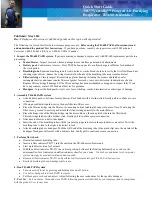
5 Installation
Installation and operation manual
8
RXYSQ6TMYFK
VRV IV-S system air conditioner
4P524881-1 – 2018.02
NOTICE
If drain holes of the outdoor unit are covered by a mounting
base or by floor surface, raise the unit to provide a free
space of more than 150 mm under the outdoor unit.
≥150 mm
Drain holes (dimensions in mm)
102
11
8
62
59
216
130
21
20
32
52
98
89
a
a
Drain holes
5.2.4
To prevent the outdoor unit from falling
over
In case the unit is installed in places where strong wind can tilt the
unit, take following measure:
1
Prepare 2 cables as indicated in the following illustration (field
supply).
2
Place the 2 cables over the outdoor unit.
3
Insert a rubber sheet between the cables and the outdoor unit
to prevent the cables from scratching the paint (field supply).
4
Attach the ends of the cables and tighten them.
5.3
Connecting the refrigerant piping
DANGER: RISK OF BURNING
5.3.1
Using the stop valve and service port
To handle the stop valve
▪ Make sure to keep all stop valves open during operation.
▪ The stop valve is factory closed.
To open the stop valve
1
Remove the stop valve cover.
2
Insert a hexagon wrench into the stop valve and turn the stop
valve counterclockwise.
3
When the stop valve cannot be turned any further, stop turning.
Result:
The valve is now open.
To fully open the Ø19.1 mm~Ø25.4 mm stop valve, turn the
hexagonal wrench until a torque between 27 and 33 N•m is
achieved.
Inadequate torque may cause leakage of refrigerant and breakage of
the stop valve cap.
1
2
3
4
NOTICE
Pay attention that mentioned torque range is applicable for
opening Ø19.1~Ø25.4 mm stop valves only.
To close the stop valve
1
Remove the stop valve cover.
2
Insert a hexagon wrench into the stop valve and turn the stop
valve clockwise.
3
When the stop valve cannot be turned any further, stop turning.
Result:
The valve is now closed.
Closing direction:
To handle the stop valve cover
▪ The stop valve cover is sealed where indicated by the arrow. Do
NOT damage it.
▪ After handling the stop valve, tighten the stop valve cover
securely, and check for refrigerant leaks. For the tightening
torque, refer to the table below.
To handle the service port
▪ Always use a charge hose equipped with a valve depressor pin,
since the service port is a Schrader type valve.
▪ After handling the service port, make sure to tighten the service
port cover securely. For the tightening torque, refer to the table
below.
▪ Check for refrigerant leaks after tightening the service port cover.









































